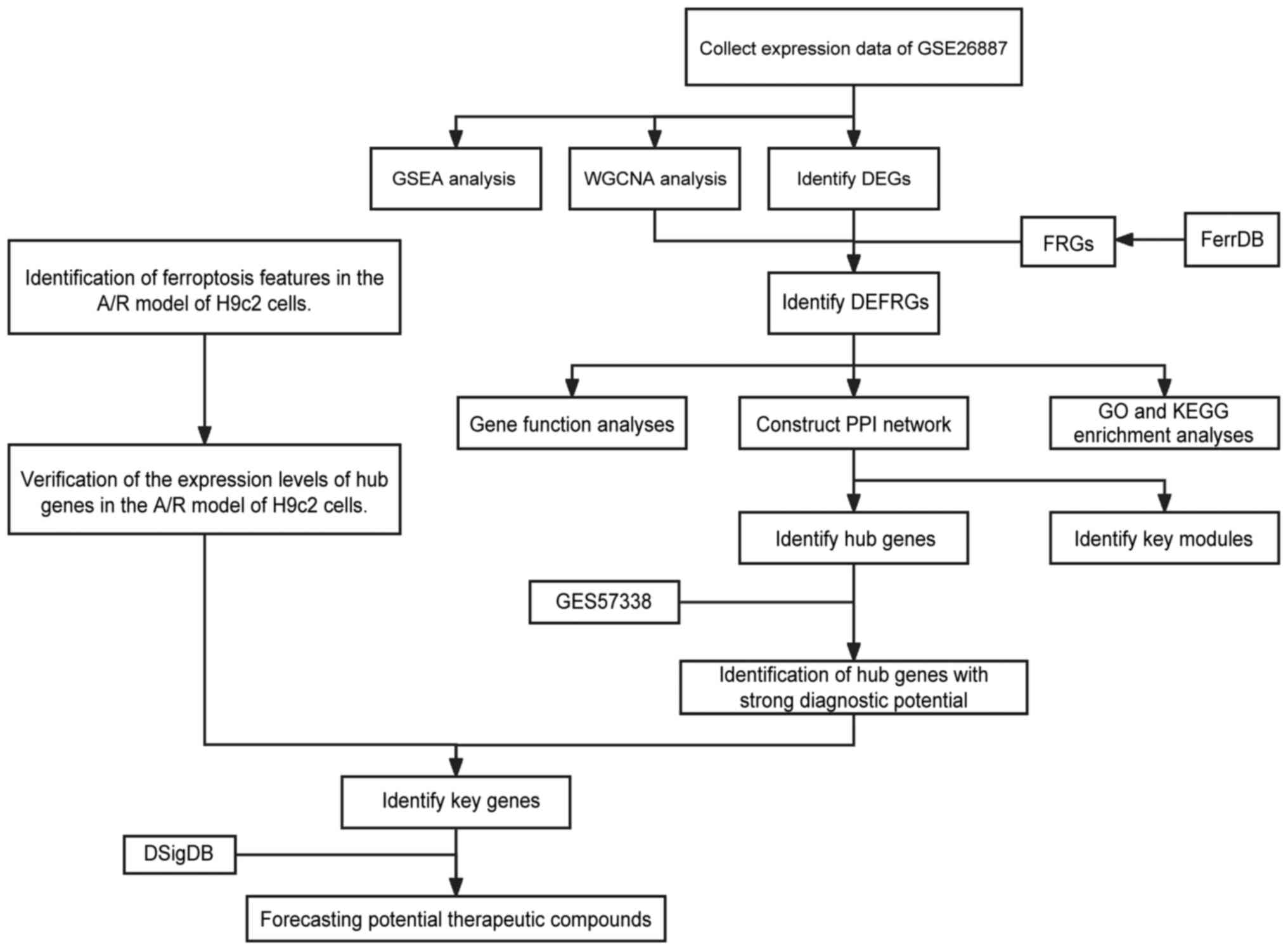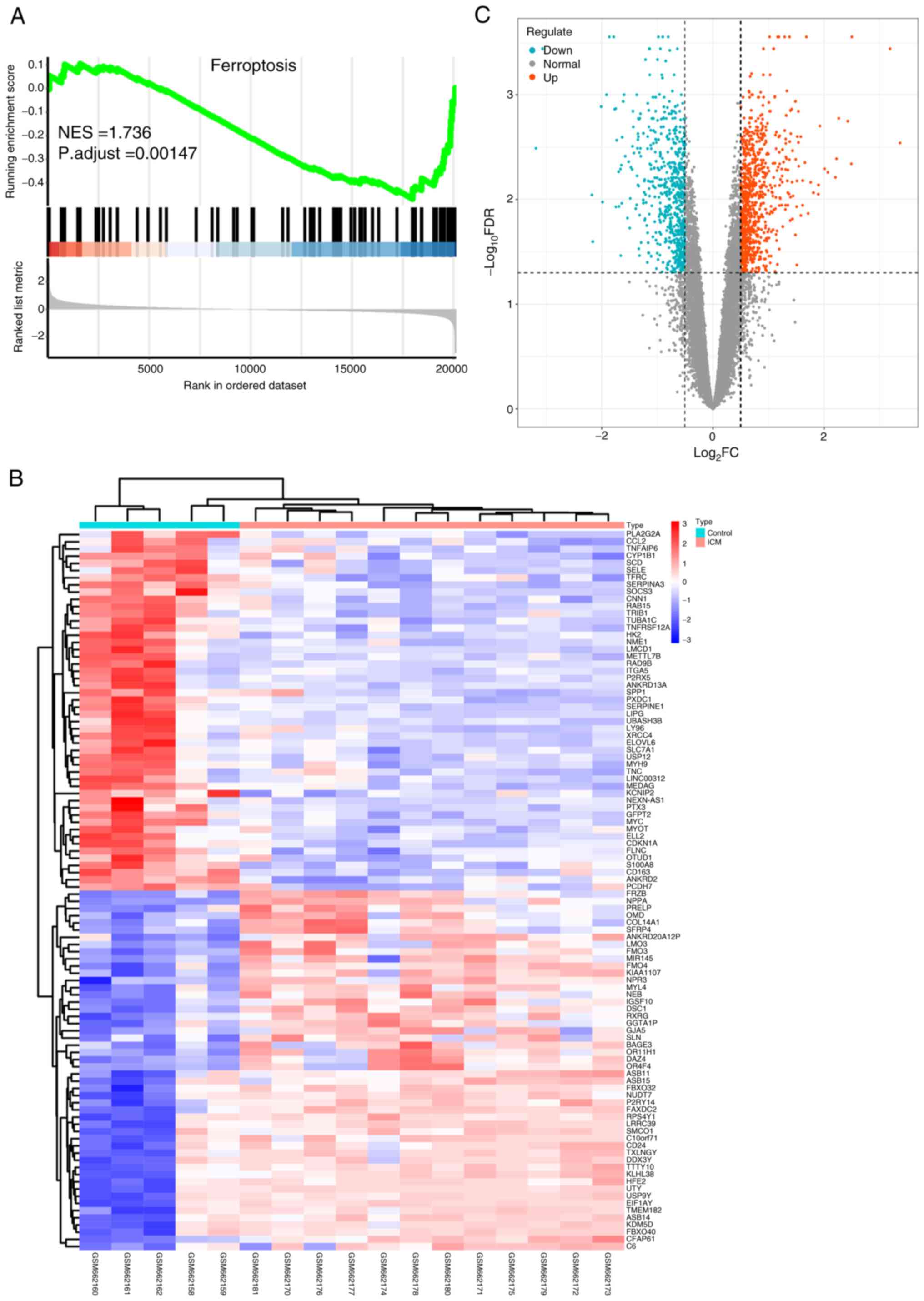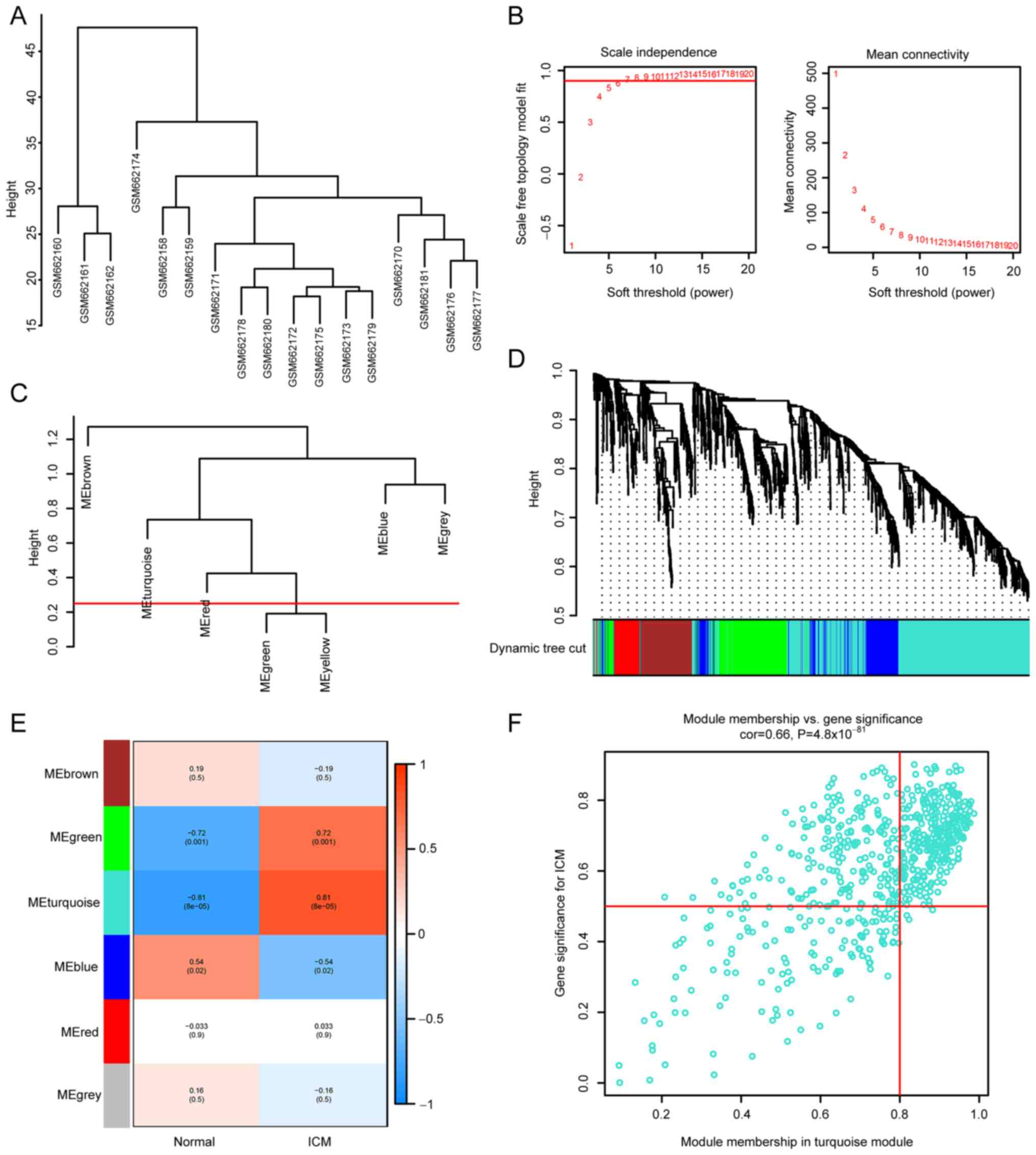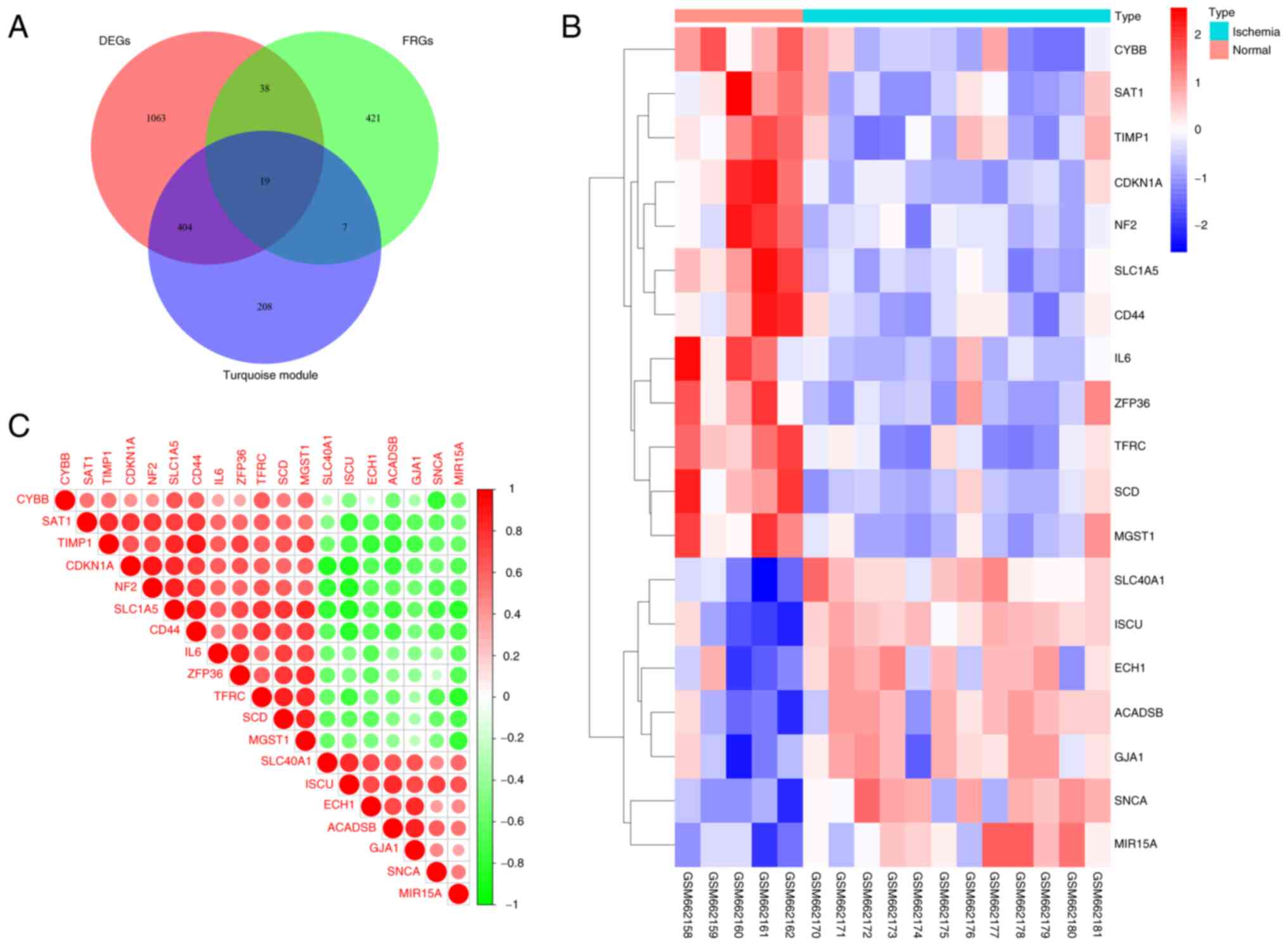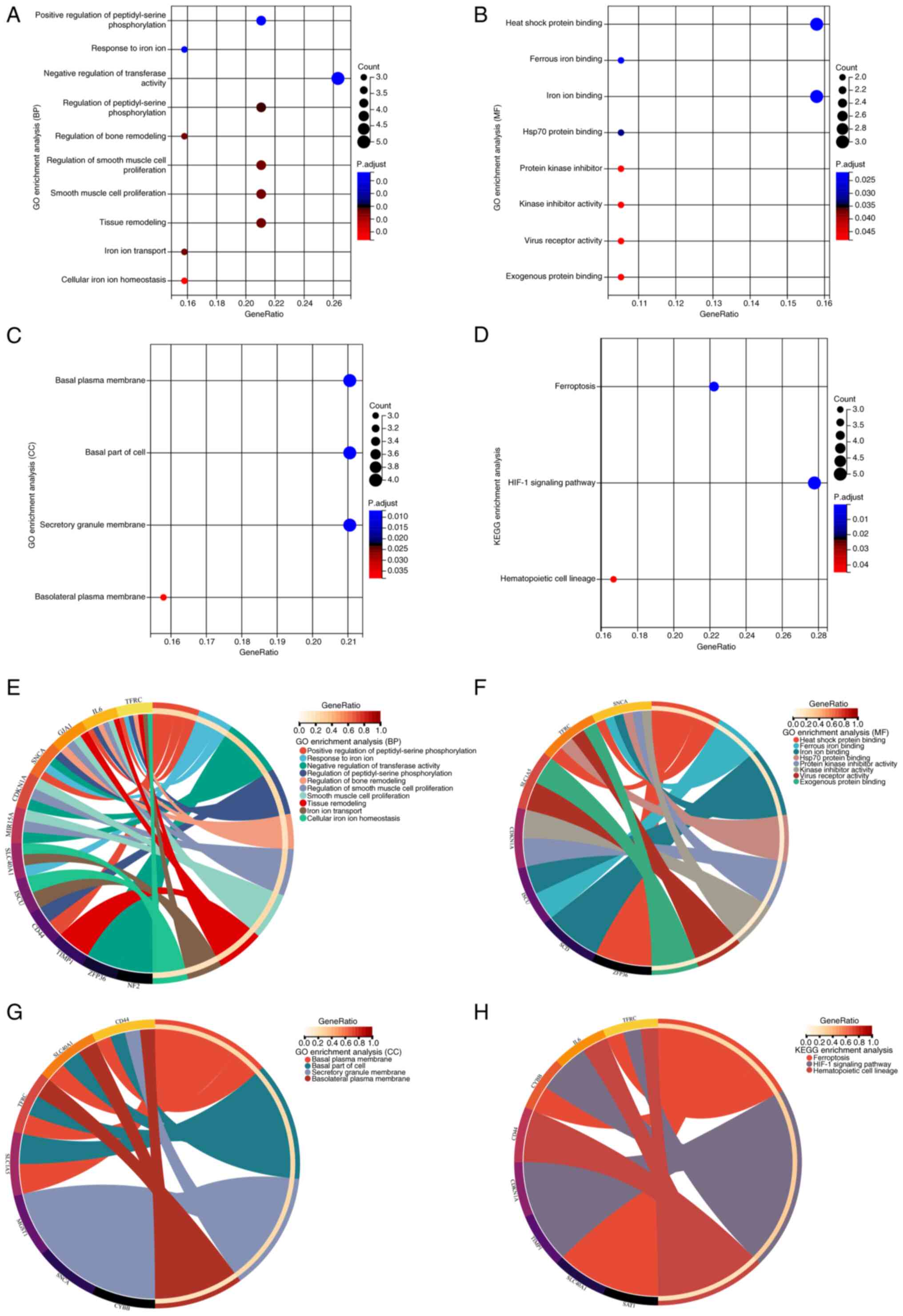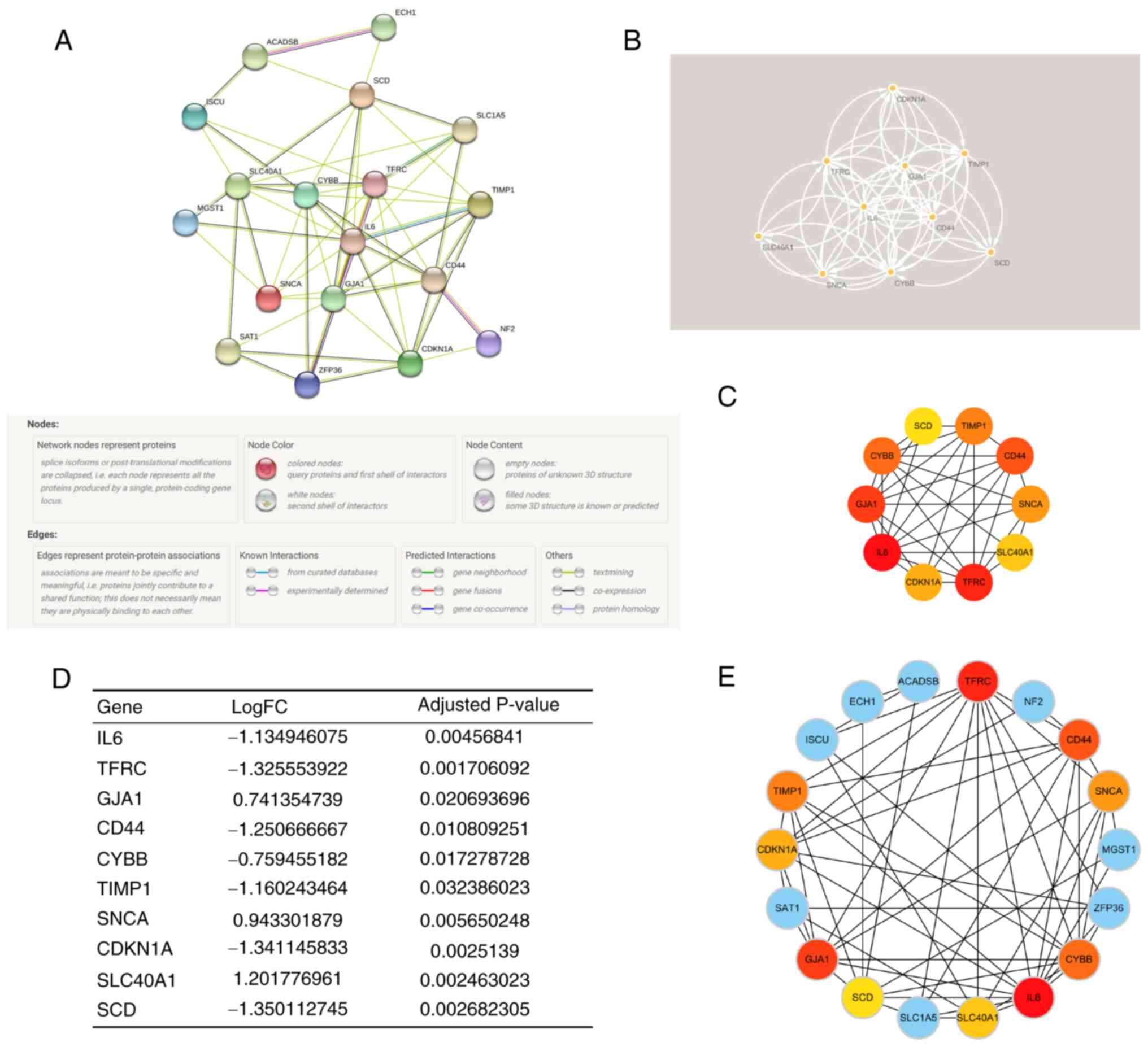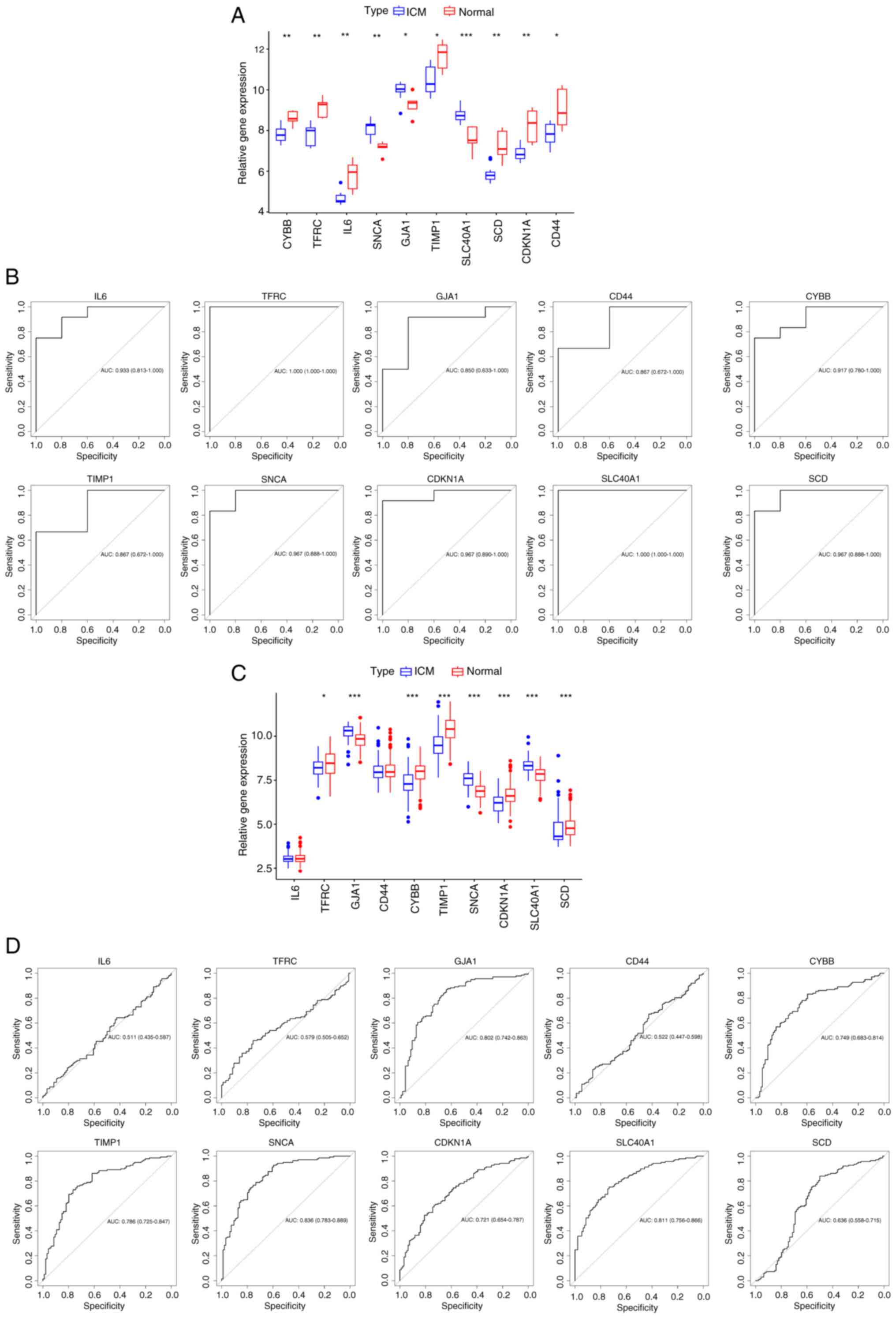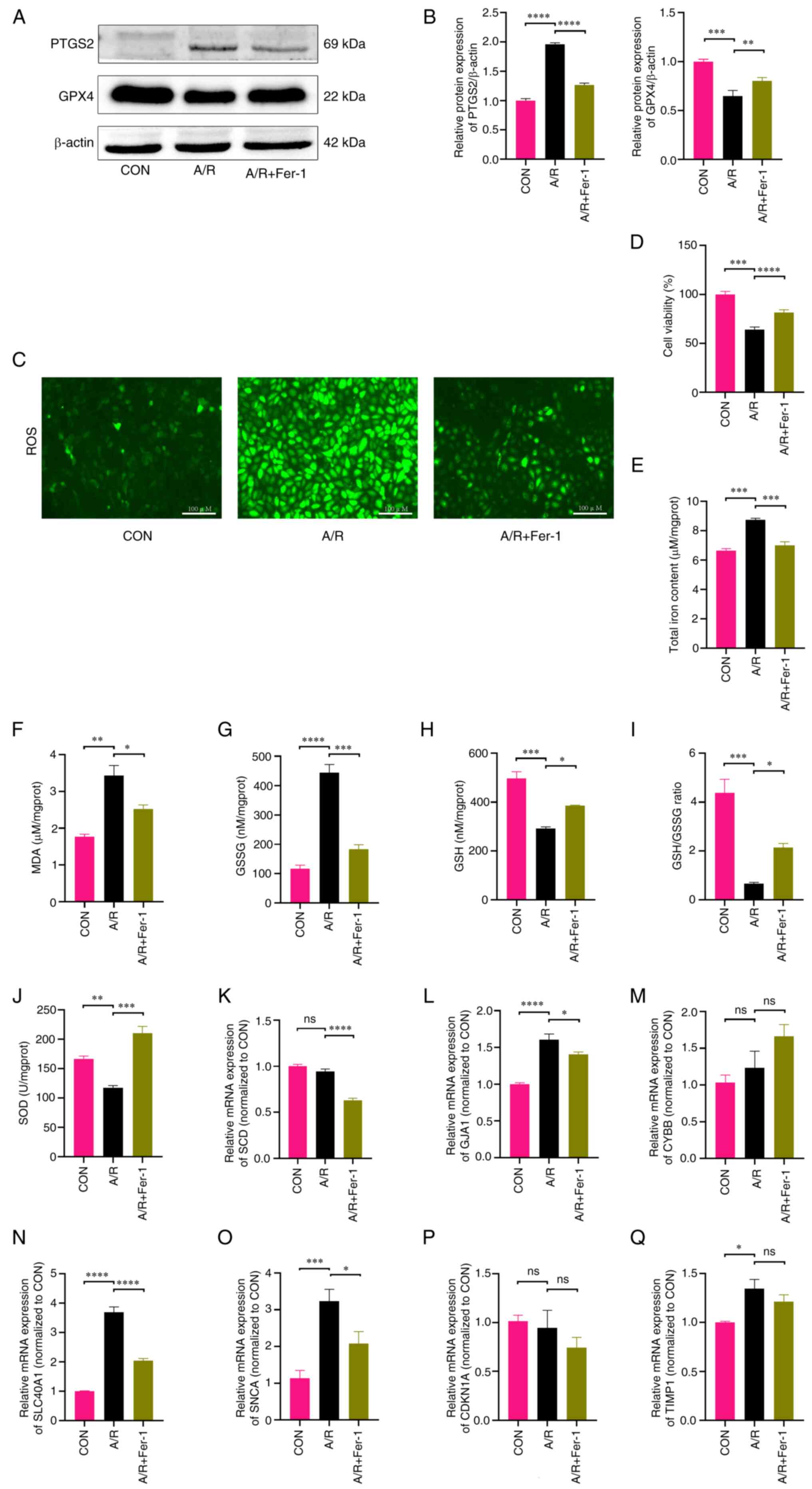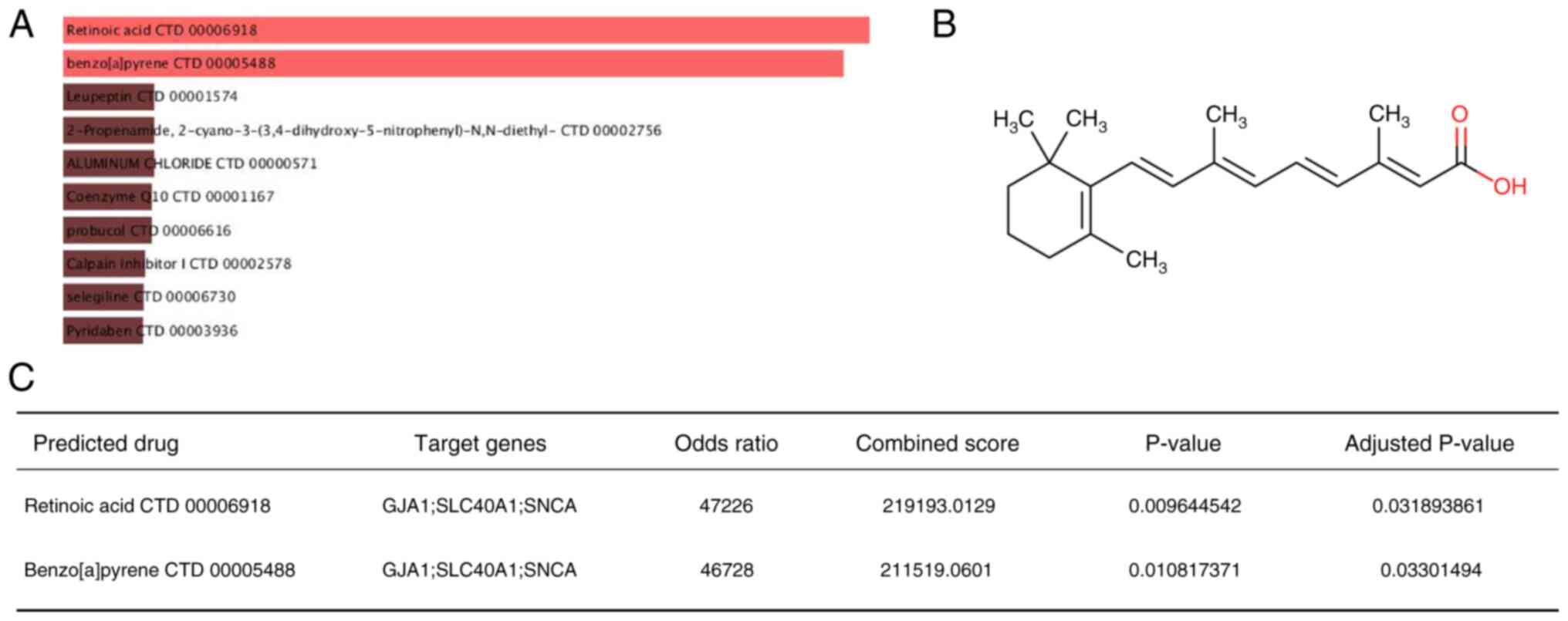|
1
|
Moroni F, Gertz Z and Azzalini L: Relief
of ischemia in ischemic cardiomyopathy. Curr Cardiol Rep.
23(80)2021.PubMed/NCBI View Article : Google Scholar
|
|
2
|
Cabac-Pogorevici I, Muk B, Rustamova Y,
Kalogeropoulos A, Tzeis S and Vardas P: Ischaemic cardiomyopathy.
Pathophysiological insights, diagnostic management and the roles of
revascularisation and device treatment. Gaps and dilemmas in the
era of advanced technology. Eur J Heart Fail. 22:789–799.
2020.PubMed/NCBI View Article : Google Scholar
|
|
3
|
Li Y, Du Y, Cao J, Gao Q, Li H, Chen Y and
Lu N: MiR-130a inhibition protects rat cardiac myocytes from
hypoxia-triggered apoptosis by targeting Smad4. Kardiol Pol.
76:993–1001. 2018.PubMed/NCBI View Article : Google Scholar
|
|
4
|
Xu Q, Liu S, Gong Q, Zhu R, Liu J, Wu Q
and Zhou X: Notch1 protects against ischemic-reperfusion injury by
suppressing PTEN-Pink1-Mediated mitochondrial dysfunction and
mitophagy. Cells. 12(137)2022.PubMed/NCBI View Article : Google Scholar
|
|
5
|
Wang X, Xie W, Zhang Y, Lin P, Han L, Han
P, Wang Y, Chen Z, Ji G, Zheng M, et al: Cardioprotection of
ischemia/reperfusion injury by cholesterol-dependent MG53-mediated
membrane repair. Circ Res. 107:76–83. 2010.PubMed/NCBI View Article : Google Scholar
|
|
6
|
Gao C, Wang R, Li B, Guo Y, Yin T, Xia Y,
Zhang F, Lian K, Liu Y, Wang H, et al: TXNIP/Redd1 signalling and
excessive autophagy: A novel mechanism of myocardial
ischaemia/reperfusion injury in mice. Cardiovasc Res. 116:645–657.
2020.PubMed/NCBI View Article : Google Scholar
|
|
7
|
Hausenloy DJ and Yellon DM: Myocardial
ischemia-reperfusion injury: A neglected therapeutic target. J Clin
Invest. 123:92–100. 2013.PubMed/NCBI View Article : Google Scholar
|
|
8
|
Hao L, Wang J and Liu N: Long noncoding
RNA TALNEC2 regulates myocardial ischemic injury in H9c2 cells by
regulating miR-21/PDCD4-medited activation of Wnt/β-catenin
pathway. J Cell Biochem. 120:12912–12923. 2019.PubMed/NCBI View Article : Google Scholar
|
|
9
|
Dixon SJ, Lemberg KM, Lamprecht MR, Skouta
R, Zaitsev EM, Gleason CE, Patel DN, Bauer AJ, Cantley AM, Yang WS,
et al: Ferroptosis: An iron-dependent form of nonapoptotic cell
death. Cell. 149:1060–1072. 2012.PubMed/NCBI View Article : Google Scholar
|
|
10
|
Stockwell BR, Friedmann Angeli JP, Bayir
H, Bush AI, Conrad M, Dixon SJ, Fulda S, Gascón S, Hatzios SK,
Kagan VE, et al: Ferroptosis: A regulated cell death nexus linking
metabolism, redox biology, and disease. Cell. 171:273–285.
2017.PubMed/NCBI View Article : Google Scholar
|
|
11
|
Wang M, Mao C, Ouyang L, Liu Y, Lai W, Liu
N, Shi Y, Chen L, Xiao D, Yu F, et al: Long noncoding RNA LINC00336
inhibits ferroptosis in lung cancer by functioning as a competing
endogenous RNA. Cell Death Differ. 26:2329–2343. 2019.PubMed/NCBI View Article : Google Scholar
|
|
12
|
Kenny EM, Fidan E, Yang Q, Anthonymuthu
TS, New LA, Meyer EA, Wang H, Kochanek PM, Dixon CE, Kagan VE and
Bayir H: Ferroptosis contributes to neuronal death and functional
outcome after traumatic brain injury. Crit Care Med. 47:410–418.
2019.PubMed/NCBI View Article : Google Scholar
|
|
13
|
Chen B, Chen Z, Liu M, Gao X, Cheng Y, Wei
Y, Wu Z, Cui D and Shang H: Inhibition of neuronal ferroptosis in
the acute phase of intracerebral hemorrhage shows long-term
cerebroprotective effects. Brain Res Bull. 153:122–132.
2019.PubMed/NCBI View Article : Google Scholar
|
|
14
|
Guan X, Li X, Yang X, Yan J, Shi P, Ba L,
Cao Y and Wang P: The neuroprotective effects of carvacrol on
ischemia/reperfusion-induced hippocampal neuronal impairment by
ferroptosis mitigation. Life Sci. 235(116795)2019.PubMed/NCBI View Article : Google Scholar
|
|
15
|
Kobayashi M, Suhara T, Baba Y, Kawasaki
NK, Higa JK and Matsui T: Pathological roles of iron in
cardiovascular disease. Curr Drug Targets. 19:1068–1076.
2018.PubMed/NCBI View Article : Google Scholar
|
|
16
|
Bulluck H, Rosmini S, Abdel-Gadir A, White
SK, Bhuva AN, Treibel TA, Fontana M, Ramlall M, Hamarneh A, Sirker
A, et al: Residual myocardial iron following intramyocardial
hemorrhage during the convalescent phase of reperfused
ST-Segment-Elevation myocardial infarction and adverse left
ventricular remodeling. Circ Cardiovasc Imaging.
9(e004940)2016.PubMed/NCBI View Article : Google Scholar
|
|
17
|
Li D, Pi W, Sun Z, Liu X and Jiang J:
Ferroptosis and its role in cardiomyopathy. Biomed Pharmacother.
153(113279)2022.PubMed/NCBI View Article : Google Scholar
|
|
18
|
Greco S, Fasanaro P, Castelvecchio S,
D'Alessandra Y, Arcelli D, Di Donato M, Malavazos A, Capogrossi MC,
Menicanti L and Martelli F: MicroRNA dysregulation in diabetic
ischemic heart failure patients. Diabetes. 61:1633–1641.
2012.PubMed/NCBI View Article : Google Scholar
|
|
19
|
Liu Y, Morley M, Brandimarto J,
Hannenhalli S, Hu Y, Ashley EA, Tang WH, Moravec CS, Margulies KB,
Cappola TP, et al: RNA-Seq identifies novel myocardial gene
expression signatures of heart failure. Genomics. 105:83–89.
2015.PubMed/NCBI View Article : Google Scholar
|
|
20
|
Edgar R, Domrachev M and Lash AE: Gene
expression omnibus: NCBI gene expression and hybridization array
data repository. Nucleic Acids Res. 30:207–210. 2002.PubMed/NCBI View Article : Google Scholar
|
|
21
|
Subramanian A, Tamayo P, Mootha VK,
Mukherjee S, Ebert BL, Gillette MA, Paulovich A, Pomeroy SL, Golub
TR, Lander ES and Mesirov JP: Gene set enrichment analysis: A
knowledge-based approach for interpreting genome-wide expression
profiles. Proc Natl Acad Sci USA. 102:15545–15550. 2005.PubMed/NCBI View Article : Google Scholar
|
|
22
|
Langfelder P and Horvath S: WGCNA: An R
package for weighted correlation network analysis. BMC
Bioinformatics. 9(559)2008.PubMed/NCBI View Article : Google Scholar
|
|
23
|
Ritchie ME, Phipson B, Wu D, Hu Y, Law CW,
Shi W and Smyth GK: limma powers differential expression analyses
for RNA-sequencing and microarray studies. Nucleic Acids Res.
43(e47)2015.PubMed/NCBI View Article : Google Scholar
|
|
24
|
Chin CH, Chen SH, Wu HH, Ho CW, Ko MT and
Lin CY: cytoHubba: Identifying hub objects and sub-networks from
complex interactome. BMC Syst Biol. 8 (Suppl 4)(S11)2014.PubMed/NCBI View Article : Google Scholar
|
|
25
|
Zhou N and Bao J: FerrDb: A manually
curated resource for regulators and markers of ferroptosis and
ferroptosis-disease associations. Database (Oxford).
2020(baaa021)2020.PubMed/NCBI View Article : Google Scholar
|
|
26
|
Bardou P, Mariette J, Escudié F, Djemiel C
and Klopp C: jvenn: An interactive Venn diagram viewer. BMC
Bioinformatics. 15(293)2014.PubMed/NCBI View Article : Google Scholar
|
|
27
|
Wu T, Hu E, Xu S, Chen M, Guo P, Dai Z,
Feng T, Zhou L, Tang W, Zhan L, et al: clusterProfiler 4.0: A
universal enrichment tool for interpreting omics data. Innovation
(Camb). 2(100141)2021.PubMed/NCBI View Article : Google Scholar
|
|
28
|
Shen W, Song Z, Zhong X, Huang M, Shen D,
Gao P, Qian X, Wang M, Li S, Song X, et al: Sangerbox: A
comprehensive, interaction-friendly clinical bioinformatics
analysis platform. iMeta. 1(e36)2022.
|
|
29
|
Szklarczyk D, Gable AL, Lyon D, Junge A,
Wyder S, Huerta-Cepas J, Simonovic M, Doncheva NT, Morris JH, Bork
P, et al: STRING v11: Protein-protein association networks with
increased coverage, supporting functional discovery in genome-wide
experimental datasets. Nucleic Acids Res. 47:D607–D613.
2019.PubMed/NCBI View Article : Google Scholar
|
|
30
|
Shannon P, Markiel A, Ozier O, Baliga NS,
Wang JT, Ramage D, Amin N, Schwikowski B and Ideker T: Cytoscape: A
software environment for integrated models of biomolecular
interaction networks. Genome Res. 13:2498–2504. 2003.PubMed/NCBI View Article : Google Scholar
|
|
31
|
Wen L, Cheng X, Fan Q, Chen Z, Luo Z, Xu
T, He M and He H: TanshinoneⅡA inhibits excessive autophagy and
protects myocardium against ischemia/reperfusion injury via
14-3-3η/Akt/Beclin1 pathway. Eur J Pharmacol.
954(175865)2023.PubMed/NCBI View Article : Google Scholar
|
|
32
|
Hu T, Zou HX, Le SY, Wang YR, Qiao YM,
Yuan Y, Liu JC, Lai SQ and Huang H: Tanshinone IIA confers
protection against myocardial ischemia/reperfusion injury by
inhibiting ferroptosis and apoptosis via VDAC1. Int J Mol Med.
52(109)2023.PubMed/NCBI View Article : Google Scholar
|
|
33
|
Livak KJ and Schmittgen TD: Analysis of
relative gene expression data using real-time quantitative PCR and
the 2(-Delta Delta C(T)) method. Methods. 25:402–408.
2001.PubMed/NCBI View Article : Google Scholar
|
|
34
|
Yoo M, Shin J, Kim J, Ryall KA, Lee K, Lee
S, Jeon M, Kang J and Tan AC: DSigDB: Drug signatures database for
gene set analysis. Bioinformatics. 31:3069–3071. 2015.PubMed/NCBI View Article : Google Scholar
|
|
35
|
Wishart DS, Feunang YD, Guo AC, Lo EJ,
Marcu A, Grant JR, Sajed T, Johnson D, Li C, Sayeeda Z, et al:
DrugBank 5.0: A major update to the DrugBank database for 2018.
Nucleic Acids Res. 46:D1074–D1082. 2018.PubMed/NCBI View Article : Google Scholar
|
|
36
|
Zou HX, Hu T, Zhao JY, Qiu BQ, Zou CC, Xu
QR, Liu JC, Lai SQ and Huang H: Exploring Dysregulated
ferroptosis-related genes in septic myocardial injury based on
human heart transcriptomes: Evidence and new insights. J Inflamm
Res. 16:995–1015. 2023.PubMed/NCBI View Article : Google Scholar
|
|
37
|
Liu K, Chen S and Lu R: Identification of
important genes related to ferroptosis and hypoxia in acute
myocardial infarction based on WGCNA. Bioengineered. 12:7950–7963.
2021.PubMed/NCBI View Article : Google Scholar
|
|
38
|
Wang Q, Liu B, Wang Y, Bai B, Yu T and Chu
XM: The biomarkers of key miRNAs and target genes associated with
acute myocardial infarction. PeerJ. 8(e9129)2020.PubMed/NCBI View Article : Google Scholar
|
|
39
|
Tarasco M, Gavaia PJ, Bensimon-Brito A,
Cardeira-da-Silva J, Ramkumar S, Cordelières FP, Günther S,
Bebianno MJ, Stainier DYR, Cancela ML and Laizé V: New insights
into benzo[α]pyrene osteotoxicity in zebrafish. Ecotoxicol Environ
Saf. 226(112838)2021.PubMed/NCBI View Article : Google Scholar
|
|
40
|
Alissa EM and Ferns GA: Heavy metal
poisoning and cardiovascular disease. J Toxicol.
2011(870125)2011.PubMed/NCBI View Article : Google Scholar
|
|
41
|
Wu X, Li Y, Zhang S and Zhou X:
Ferroptosis as a novel therapeutic target for cardiovascular
disease. Theranostics. 11:3052–3059. 2021.PubMed/NCBI View Article : Google Scholar
|
|
42
|
Del Re DP, Amgalan D, Linkermann A, Liu Q
and Kitsis RN: Fundamental mechanisms of regulated cell death and
implications for heart disease. Physiol Rev. 99:1765–1817.
2019.PubMed/NCBI View Article : Google Scholar
|
|
43
|
Fang X, Ardehali H, Min J and Wang F: The
molecular and metabolic landscape of iron and ferroptosis in
cardiovascular disease. Nat Rev Cardiol. 20:7–23. 2023.PubMed/NCBI View Article : Google Scholar
|
|
44
|
Feng Y, Madungwe NB, Imam Aliagan AD,
Tombo N and Bopassa JC: Liproxstatin-1 protects the mouse
myocardium against ischemia/reperfusion injury by decreasing VDAC1
levels and restoring GPX4 levels. Biochem Biophys Res Commun.
520:606–611. 2019.PubMed/NCBI View Article : Google Scholar
|
|
45
|
Li W, Li W, Leng Y, Xiong Y and Xia Z:
Ferroptosis is involved in diabetes myocardial ischemia/reperfusion
injury through endoplasmic reticulum stress. DNA Cell Biol.
39:210–225. 2020.PubMed/NCBI View Article : Google Scholar
|
|
46
|
Baba Y, Higa JK, Shimada BK, Horiuchi KM,
Suhara T, Kobayashi M, Woo JD, Aoyagi H, Marh KS, Kitaoka H and
Matsui T: Protective effects of the mechanistic target of rapamycin
against excess iron and ferroptosis in cardiomyocytes. Am J Physiol
Heart Circ Physiol. 314:H659–H668. 2018.PubMed/NCBI View Article : Google Scholar
|
|
47
|
Andrews NC: Forging a field: The golden
age of iron biology. Blood. 112:219–230. 2008.PubMed/NCBI View Article : Google Scholar
|
|
48
|
Gao G, Li J, Zhang Y and Chang YZ:
Cellular Iron Metabolism and Regulation. Adv Exp Med Biol.
1173:21–32. 2019.PubMed/NCBI View Article : Google Scholar
|
|
49
|
Paterek A, Mackiewicz U and Mączewski M:
Iron and the heart: A paradigm shift from systemic to cardiomyocyte
abnormalities. J Cell Physiol. 234:21613–21629. 2019.PubMed/NCBI View Article : Google Scholar
|
|
50
|
Zhang QJ, He Y, Li Y, Shen H, Lin L, Zhu
M, Wang Z, Luo X, Hill JA, Cao D, et al: Matricellular protein
cilp1 promotes myocardial fibrosis in response to myocardial
infarction. Circ Res. 129:1021–1035. 2021.PubMed/NCBI View Article : Google Scholar
|
|
51
|
Schroer AK, Bersi MR, Clark CR, Zhang Q,
Sanders LH, Hatzopoulos AK, Force TL, Majka SM, Lal H and Merryman
WD: Cadherin-11 blockade reduces inflammation-driven fibrotic
remodeling and improves outcomes after myocardial infarction. JCI
Insight. 4(e131545)2019.PubMed/NCBI View Article : Google Scholar
|
|
52
|
Snider JC, Riley LA, Mallory NT, Litsky
AS, Stoodley P, Swinehart SD, Duerr RA, Kaeding CC and Flanigan DC:
Targeting 5-HT2B receptor signaling prevents border zone expansion
and improves microstructural remodeling after myocardial
infarction. Circulation. 143:1317–1330. 2021.PubMed/NCBI View Article : Google Scholar
|
|
53
|
Humeres C and Frangogiannis NG:
Fibroblasts in the Infarcted, remodeling, and failing heart. JACC
Basic Transl Sci. 4:449–467. 2019.PubMed/NCBI View Article : Google Scholar
|
|
54
|
Talman V and Ruskoaho H: Cardiac fibrosis
in myocardial infarction-from repair and remodeling to
regeneration. Cell Tissue Res. 365:563–581. 2016.PubMed/NCBI View Article : Google Scholar
|
|
55
|
Chen Y, Li X, Wang S, Miao R and Zhong J:
Targeting iron metabolism and ferroptosis as novel therapeutic
approaches in cardiovascular diseases. Nutrients.
15(59)2023.PubMed/NCBI View Article : Google Scholar
|
|
56
|
Angelova PR, Choi ML, Berezhnov AV,
Horrocks MH, Hughes CD, De S, Rodrigues M, Yapom R, Little D, Dolt
KS, et al: Alpha synuclein aggregation drives ferroptosis: An
interplay of iron, calcium and lipid peroxidation. Cell Death
Differ. 27:2781–2796. 2020.PubMed/NCBI View Article : Google Scholar
|
|
57
|
Yu M, Lin Z, Tian X, Chen S, Liang X, Qin
M, Zhu Q, Wu Y and Zhong S: Downregulation of Cx43 reduces
cisplatin-induced acute renal injury by inhibiting ferroptosis.
Food Chem Toxicol. 158(112672)2021.PubMed/NCBI View Article : Google Scholar
|
|
58
|
Huang Q, Sha W, Gu Q, Wang J, Zhu Y, Xu T,
Xu Z, Yan F, Lin X and Tian S: Inhibition of Connexin43 improves
the recovery of spinal cord injury against ferroptosis via the
SLC7A11/GPX4 pathway. Neuroscience. 526:121–134. 2023.PubMed/NCBI View Article : Google Scholar
|
|
59
|
Beutler E, Barton JC, Felitti VJ, Gelbart
T, West C, Lee PL, Waalen J and Vulpe C: Ferroportin 1 (SCL40A1)
variant associated with iron overload in African-Americans. Blood
Cells Mol Dis. 31:305–309. 2003.PubMed/NCBI View Article : Google Scholar
|
|
60
|
Wiggert B, Bergsma DR, Helmsen R and
Chader GJ: Vitamin A receptors. Retinoic acid binding in ocular
tissues. Biochem J. 169:87–94. 1978.PubMed/NCBI View Article : Google Scholar
|
|
61
|
Choudhary R, Baker KM and Pan J: All-trans
retinoic acid prevents angiotensin II- and mechanical
stretch-induced reactive oxygen species generation and
cardiomyocyte apoptosis. J Cell Physiol. 215:172–181.
2008.PubMed/NCBI View Article : Google Scholar
|
|
62
|
Lou S, Zhong L, Yang X, Xue T, Gai R, Zhu
D, Zhao Y, Yang B, Ying M and He Q: Efficacy of all-trans retinoid
acid in preventing nickel induced cardiotoxicity in myocardial
cells of rats. Food Chem Toxicol. 51:251–258. 2013.PubMed/NCBI View Article : Google Scholar
|
|
63
|
Nizamutdinova IT, Guleria RS, Singh AB,
Kendall JA, Baker KM and Pan J: Retinoic acid protects
cardiomyocytes from high glucose-induced apoptosis through
inhibition of NF-κB signaling pathway. J Cell Physiol. 228:380–392.
2013.PubMed/NCBI View Article : Google Scholar
|
|
64
|
Yamaguchi A, Uchida M, Ishibashi H, Hirano
M, Ichikawa N, Arizono K, Koyama J and Tominaga N: Potential
mechanisms underlying embryonic developmental toxicity caused by
benzo[a]pyrene in Japanese medaka (Oryzias latipes). Chemosphere.
242(125243)2020.PubMed/NCBI View Article : Google Scholar
|
|
65
|
Feng B, Li L, Xu H, Wang T, Wu R, Chen J,
Zhang Y, Liu S, Ho SSH, Cao J and Huang W: PM2.5-bound polycyclic
aromatic hydrocarbons (PAHs) in Beijing: Seasonal variations,
sources, and risk assessment. J Environ Sci (China). 77:11–19.
2019.PubMed/NCBI View Article : Google Scholar
|
|
66
|
Wu Y, Huang T, Li X, Shen C, Ren H, Wang
H, Wu T, Fu X, Deng S, Feng Z, et al: Retinol dehydrogenase 10
reduction mediated retinol metabolism disorder promotes diabetic
cardiomyopathy in male mice. Nat Commun. 14(1181)2023.PubMed/NCBI View Article : Google Scholar
|















